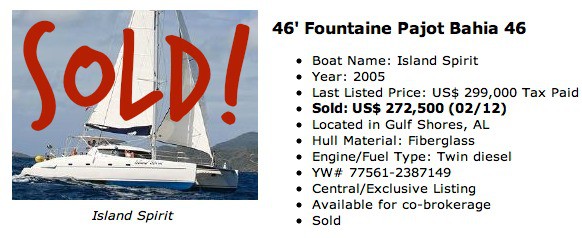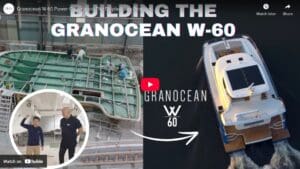 If you choose to be your own yacht trader without a buyer’s broker, this checklist links to handy tools that will help you avoid common mistakes. We have worked with thousands of boat buyers and they always are very anxious about all the paperwork and documents required to complete the sale of a yacht. So this checklist can help you be mindful not to miss deadlines and point you in the right directions to do your research.
If you choose to be your own yacht trader without a buyer’s broker, this checklist links to handy tools that will help you avoid common mistakes. We have worked with thousands of boat buyers and they always are very anxious about all the paperwork and documents required to complete the sale of a yacht. So this checklist can help you be mindful not to miss deadlines and point you in the right directions to do your research.
To make buying a yacht a more pleasant and less risky transaction, we recommend that you have a good team on your side in your yacht broker, yacht surveyor and documentation agent. Similar to real estate sales, sellers pay the commission on a boat sale, so it won’t cost you anything extra to have a yacht broker on your side. As a licensed and bonded yacht broker in Florida, we operate under a strict set of legal guidelines and ethical standards, and it’s good to have us on your side during a transaction.
If you are an inexperienced boat buyer, you may be better served by having your own yacht broker to do the negotiations. However, if you want to go it alone, here are some guidelines to follow. Also read Boat Buying Tips and Charter Boat Buying Tips.
Yacht Financing
Once you have identified the boat you want to buy, you will likely need a bank loan to finance the purchase. Yacht trading is not as common as a home mortgage so it can be a challenging process. Generally, we recommend that our clients get pre-qualified for a bank loan before they start looking for a boat. With that pre-qualification in hand and a down payment of 20%, sellers are much more eager to negotiate.
Calculate the loan amount you can afford. Our recommended marine loan calculators can help you determine a loan amount that fits your budget. Things to keep in mind:
- Lenders will finance a yacht for up to 80% with a minimum 20% down payment for a term of 15 years. We do not recommend 20 years.
- Your monthly payment is based on buying a boat for $100,000. Financing $80,000 for 15 years at 5.5% equals a monthly payment of $653.67.
- Sales tax and US Coast Guard documentation are your only closing costs. The documentation agent and surveyor are paid directly by the buyer.
- Many banks will not finance live-aboards. Do not mention it in your initial applications.
- Lenders do not recognize charter income as additional income to qualify for a loan. Do not mention it in your initial applications.
- Tax Tip: Loan interest payments are deductible in the U.S. as “second home mortgage interest expenses”, unless you already take this deduction on a second home.
- What banks are looking for as a “good risk” to be able to fund your loan is:
- a maximum 40% debt-to-income ratio…learn to calculate your debt-to-income ratio
- a personal balance sheet that shows a net worth capable of covering the loan
- liquidity of at least one year of mortgage payments (these can be in the form of a restricted qualified retirement fund such as an IRA, 401K, or SEP)
- a credit score above 700
- a loan history for a similar amount
- copies of last two years’ tax returns.
Other Financial Things To Look Out For
- Make sure the loan is simple interest, and that there is no pre-payment penalty.
- Do not submit applications to multiple lenders. Multiple inquiries lower your credit score.
Read our article: Tips To An Affordable Yacht Loan
Get Pre-Qualified For A Marine Loan
Get pre-qualified for marine financing in advance of purchasing a new catamaran from one of our recommended marine lenders. Getting pre-qualified is the initial step in the boat loan process. Applicants provide their overall financial picture (income, assets, debts…). Credit reports are not pulled. After evaluating this initial information, your lending specialist will inform you of the loan amount that you may qualify for. Contact us for recommendations for the best lender for your situation.
Start Your Yacht Trader Journey with an Offer
 You have found your dream boat and are ready to buy. The first steps in the yacht trader process are:
You have found your dream boat and are ready to buy. The first steps in the yacht trader process are:
- Make an “offer to purchase”.
- Prepare a written offer in the form of a Purchase & Sale Agreement.
- When we present offers, we usually go in at about 80% of the asking price as a starting point. The seller will counter, we will counter again, and this process will go back and forth until a mutually agreed upon price is reached.
- Consider whether you want to purchase the boat “as is” which can provide a lower sales price and quicker closing. This may be advantageous if you are are a DIY boat repair type of person or if you have trusted resources who can make repairs
- Or if you want the seller to assume responsibility for resolving issues, then you will want to include surveys and sea trial in the terms and can expect more back-and-forth negotiation.
- Include a 10% deposit to an escrow account to the benefit of the seller, pending satisfactory survey, mechanical and engine inspections, and sea trial.
- Once the Purchase & Sale Agreement is signed by the seller and buyer at an agreed upon price, the buyer can schedule a haulout and a surveyor.
- The buyer has a timeframe in which to complete survey (usually two weeks, but sometimes longer). This is referred to as the acceptance-rejection date.
- The seller is bound by the contract and prohibited from selling the vessel to anyone else, even if a better offer comes along.
- The buyer can, at any point before the acceptance-rejection date, pull out of the deal and get a full refund of the 10% escrowed deposit.
Basic Purchase and Sale Agreement Contract Terms
The Purchase and Sale Agreement defines the name of the vessel, the offer price (or when signed, the agreed-upon sales price), and terms of the agreement. It should include the following minimum information:
- Complete names and addresses of buyer and seller.
- Complete description of boat and engine, including make, model, year, and Hull Identification Number (HIN) and engine serial number(s).
- A complete equipment / inventory list.
- The purchase price, including deposits paid by buyer and how the balance will be paid (for example, certified check).
- A firm acceptance-rejection date describing when and where the deal will be finalized after they buyer completes due diligence (surveys, sea trial, etc.).
- The condition of the boat at the time of acceptance.
- Buyer’s contingencies: Spell out that the sale hinges on a satisfactory survey and sea trial and the ability to obtain acceptable financing and marine insurance.
- A statement that the boat is free of all liens and encumbrances.
- The seller should also assume all responsibility for debts incurred during his ownership.
Once the price is agreeable to the buyer and seller, the purchase and sale agreement is signed, deposits made, and the boat is “under offer”.
Read more about yacht purchase and sale agreements including sample documents.
Survey and Sea-Trial
- M
 ost offers to purchase contain conditions (contingencies). The most common is your right to survey, inspect and a sea-trial. We absolutely recommend you conduct a boat survey. It is in your interest to select your own independent surveyor and your broker (if you have one) will be able to give you a list of the three closest accredited surveyors to the vessel. But you must interview them and choose the person that you would like to work with. If you have no broker, see our recommended yacht surveyors or go to Society of Accredited Marine Surveyor (SAMS) for a list of accredited surveyors in area close to the vessel. Costs vary depending on the vessel location, distance from selected surveyor and type of vessel. Some surveyors will also conduct an analysis on the engine(s). If not, they may have recommendations.
ost offers to purchase contain conditions (contingencies). The most common is your right to survey, inspect and a sea-trial. We absolutely recommend you conduct a boat survey. It is in your interest to select your own independent surveyor and your broker (if you have one) will be able to give you a list of the three closest accredited surveyors to the vessel. But you must interview them and choose the person that you would like to work with. If you have no broker, see our recommended yacht surveyors or go to Society of Accredited Marine Surveyor (SAMS) for a list of accredited surveyors in area close to the vessel. Costs vary depending on the vessel location, distance from selected surveyor and type of vessel. Some surveyors will also conduct an analysis on the engine(s). If not, they may have recommendations. - As the buyer, you need to coordinate the haulout, survey, and sea-trial with all interested parties. Most often, the seller arranges the captain for the sea-trial. If buying a phase-out charter yacht, you will coordinate with the charter fleet’s phase-out team. The haulout, or hang and hold as it’s called, is usually scheduled for early in the day so that the sea-trial can be done the same day.
- It may take up to 2 days after survey for you to receive your written report from your surveyor. It typically includes photos of important areas on the vessel that are discussed. A good surveyor will point out every area that needs any amount of attention.
Conditional Acceptance of Vessel and Re-Negotiation
- After reviewing your survey, you may reject the vessel because of the survey findings (or for any reason, or no reason). Your deposit will be wired back to your bank.
- If you choose to accept the vessel but want to be compensated for defects or have defects fixed, you will enter into another set of negotiations with the seller by writing up a Conditional Acceptance of Vessel (CAOV) citing the deficiencies you want remedied prior to final acceptance of the vessel. Note that remedying does not necessarily mean new parts and equipment, it only means that the deficiency be returned to good working order.
- It is expected, after the survey, that the buyer will re-negotiate the price based on repairs that must be made. Would the seller be willing to make the repairs himself, or reduce the sale price?
- Usually the seller will reduce the price but be reasonable. Don’t expect perfectly new counter tops on a 15-year old boat. Fair wear and tear is reasonable, but osmosis, a major repair, is not.
- It can require 6-8 weeks to complete repairs after the amended agreement between the buyer and seller is updated by the CAOV.
- Following the repairs, some surveyors complete a follow-up survey to confirm the repairs as part of their survey price.
- The CAOV contains:
- the final amount due to purchase the vessel, the purchase price minus the 10% deposit.
- statement that the buyer accepts the condition of vessel “as is” with the condition that agreed upon repairs are done satisfactorily or with an agreed upon price reduction.
- This document has a time constraint (usually 10 days) and must be adhered to or you will be out of contract and all bets are off. If you need more time, an addendum must be added that is signed by yourself and the seller that extends the date for acceptance or closing.
Yacht Insurance
You will be required to purchase yacht insurance immediately after final price negotiations. This is primarily for the benefit of your finance company. Most finance companies won’t write a check until the buyer can show proof of insurance. Read our tips on the pitfalls of marine insurance.
See our recommended marine insurance company resources.
Bill of Sale
A Bill of Sale is drawn up with the buyer’s details and the seller’s details, the vessel information, and purchase price. The Bill of Sale needs to be signed and dated by the buyer and the seller to be consummated.
Final Payment and Closing Statement
 This is the summary of the deal for the seller and the buyer. The Buyer’s Financial Statement shows the final balance due to complete the purchase. The buyer wires the funds.
This is the summary of the deal for the seller and the buyer. The Buyer’s Financial Statement shows the final balance due to complete the purchase. The buyer wires the funds.
The funds must clear the escrow account prior to closing. Wires can be delayed, especially international transactions, so completing the wire at least 2 days, and a week for international is recommended. Once the funds clear in the escrow account and all documents are signed, the closing is done and funds are dispersed to the seller (and/or the seller’s bank if a payoff is necessary to receive the title).
Vessel Documentation
Vessel documentation is a national form of registration and provides conclusive evidence of nationality for international purposes. Your documentation agent will make sure that the boat title is free and clear of any encumbrances and liens. They will de-register/de-flag the boat, transfer ownership to the buyer, and register the boat in the new buyer’s name. It is important to have your own documentation agent to ensure that all paperwork and documentation is in order before money is paid to the seller. Important documents are: Tax Paid Statement, signed Bill of Sale, and signed-over Title. See FAQs about yacht documentation.
The bank will require U.S. Flagging of the boat (Coast Guard Documentation). This is in your and the bank’s best interest. They get their lien recorded. You get a clear title that’s easy to deal with at settlement when you sell. Settlement costs are typically about $500 for documentation or around $300-$400 if you set up an LLC.
See our recommended vessel documentation agents.
Sales Tax
Every state is different, so for this exercise, I will discuss the Florida state rule. Please check with your own state for requirements. Sales tax is due on all boat sales within the State of Florida if the vessel is located in Florida and staying in Florida. To register the vessel in your name, most states will require you to bring the Tax Paid statement. The new boat owner does not pay sales or use tax to the seller. The taxes are paid when boat is registered with the Department of Highway Safety & Motor Vehicles, County Tax Collector, or licensed private tag agency.
Read this article about Florida Sales and Use Tax.
You do not avoid sales or use taxes by registering a boat in Delaware (or any other non-sales tax state) and it makes no difference whether you’re a state resident or not. If you use the boat in the state a majority of the time, the use tax is due to the state. By locating a boat in the Bahamas or the Caribbean for the majority of the year, the tax can legitimately be avoided. If the tax is due, it is 6% in Florida, capped at $18,000. Generally, once you pay it in one state, you don’t pay it again in another, unless they have a personal property tax, like in Virginia.
Out of State Sales and International Sales
The yacht buyer will be required to sign a Florida Tax Affidavit that will confirm that the buyer will be moving the vessel out of Florida after purchase and no taxes are due. It is required to file this paperwork with the State of Florida within 5 days of the closing.
More information:
You Will Need The Following Sales Documents
You will need some documents to complete the sale. The four most important documents are:
- Purchase and Sale Agreement
- Acceptance of Vessel
- Closing Statement
- Bill of Sale
Learn more about buying catamarans. We also have a wealth of information about selling a catamaran in case you need to sell before or after you buy your new dream boat.
Let a Broker Make it Easier
Sellers pay brokers’ commissions so using a broker costs you nothing! Why go it alone? Let us help you reduce risks and stress of selecting the right yacht and going through the yacht buying process. We are eager to meet you
Contact a Broker Directly
Our brokers don’t just excel at buying and selling catamarans, they live the lifestyle. Each of our brokers have been a part of the Catamaran Guru community for years because they love and live everything catamaran.
* Please note: None of the companies listed in this article are recommended by Catamaran Guru specifically. We have worked with most of them and have had good results but please, always do your own research.






